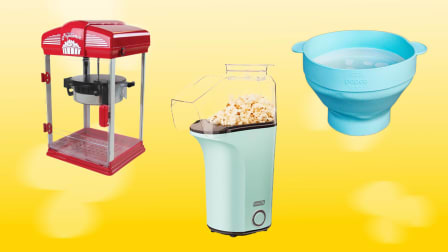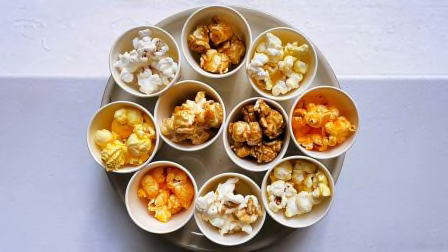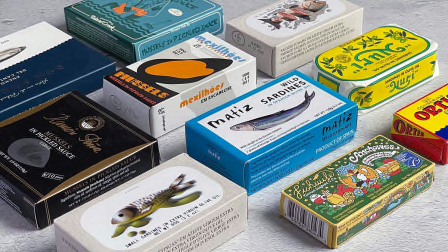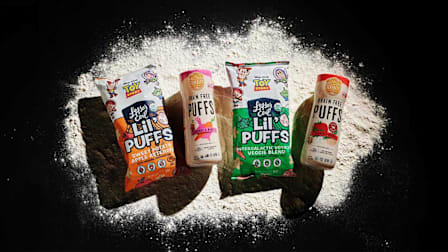How to Snack for Better Health
Enjoy between-meal eating that's actually good for you
When you shop through retailer links on our site, we may earn affiliate commissions. 100% of the fees we collect are used to support our nonprofit mission. Learn more.
When you hear the word “snack,” chances are you think chips and cookies, and therefore believe snacking is something to be avoided.
But eating between meals can be good for you—if you make healthful choices. And older people may actually need to snack to compensate for eating less at meals.
“Medication, depression, changes in taste and smell, and a drop in activity level can all cause a decline in appetite,” says Lauri Wright, Ph.D., chair of the department of nutrition and dietetics at the University of North Florida in Jacksonville.
When you eat less at one sitting, it can be difficult to get the energy, vitamins, and minerals needed from three meals alone.
“Snacking—or eating six mini meals a day instead of only three—can fill in the gaps,” Wright says.
In a study published in the Journal of the Academy of Nutrition and Dietetics, snacks contributed significantly to the overall intake of many important nutrients, supplying, for example, 18 percent of the calcium and magnesium, 16 percent of the vitamin E and potassium, and 15 percent of the vitamin C older adults took in each day.
In addition, the amounts of these nutrients and others increased as the frequency of snacking increased. Other research shows that snacking also boosts protein intake. Use these tips to help you snack right.
Know Your Nutrients
A diet rich in vitamins and other nutrients can help prevent disease and support everything from your bones to your heart. Experts suggest using snack time to increase your intake of the following, which may be lacking in an older person’s diet:
Follow This Formula
To get all the nutrients your body needs, snack on a variety of foods—and go for a combination of protein and carbohydrates at every snack.
“Your body burns carbohydrates more quickly,” Wright says. “Protein provides a slower, more sustained energy release to help you feel full longer.”
And don’t shy away from fat! Healthy fats—such as avocado, hummus, nuts and seeds, and olive oil—in snacks will boost satiety. Plus, fat is key for the absorption of vitamins A, D, E, and K.
10 Easy Snack Ideas
Though meals are usually planned in advance, a majority of snacks aren’t, a 2014 study published in the Journal of the American College of Nutrition found. That spontaneity can lead you to go for ease rather than nutrition.
“People think of snacks as prepackaged items, like chips,” Morse says. “We need to switch the mindset and consider nourishing foods we prepare.”
But that doesn’t mean you need to whip up complicated recipes or nosh on unfamiliar ingredients. Proof: these expert-approved, healthful, easy options.
Banana and peanut butter. It’s the ideal combination of protein, carbs, and healthy fat—plus potassium.
Plain yogurt, whole-grain cereal, and berries. This tasty parfait layers up fiber, protein, calcium, and potassium.
Oatmeal, chia seeds, and chopped apple. Mix protein- and nutrient-packed seeds into hot cereal for a flavorful, fiber-filled mini meal. The apple adds potassium plus a hit of natural sweetness.
Turkey and avocado on a slice of whole-wheat bread. Mini sandwiches can be a perfect portable snack.
Lentil soup. Try snacking on smaller portions of your favorite healthful meals, like bean soups. (Choose lower-sodium if you opt for a canned variety.)
Baked sweet potato with olive oil and cinnamon. Keep a few whole baked tubers in the fridge so that you can easily heat and eat when hunger strikes.
Whole-grain crackers with hummus. Hummus has protein and healthy fats, and the crackers supply some fiber.
Roasted, spiced chickpeas. Rich in both protein and fiber, chickpeas are a healthy snack and are easy and quick to make. You can season them with cinnamon, garam masala, or whatever herbs and spices you like and roast them in a toaster oven or crisp them in an air fryer. Try this recipe.
Homemade smoothie. Smoothies from juice bars or the supermarket may be loaded with added sugars. Making them yourself lets you control the ingredients. Just keep some nut butter, frozen fruit, and plain yogurt on hand and it will only take a few minutes to whip one up in your blender. Try one of these protein-fiber packed smoothies from CR’s test kitchens.
Some energy bars. Sometimes you really need a grab-and-go snack. In those cases, if you choose carefully, an energy bar can be a good option. Many have overly processed ingredients and added sugars, so look for one with 150 to 200 calories, 3 grams of fiber, 3 to 6 grams of protein, and few, if any, added sugars (such as cane sugar or brown-rice syrup) in the ingredients list. In CR’s tests of 33 energy bars, it found six that earned a Very Good score for nutrition.
Conquer That Craving
The next time you have a hankering for something high in fat or sugar, try one of these swaps from Wesley Delbridge, R.D.N., a spokesperson for the Academy of Nutrition and Dietetics.
Instead of: Potato chips
Try: Air-popped popcorn and a handful of nuts
Why: You still get a satisfying crunch and a little salt, and corn, a whole grain, provides fiber. Plus the nuts contain protein and healthy fat.
Instead of: A doughnut
Try: One slice of whole-wheat toast with 1 tablespoon of nut butter and sliced strawberries
Why: Whole grains provide fiber; almond butter has protein and healthy fat; and berries add sweetness with fewer sugars than jam.
Instead of: A candy bar
Try: Walnuts and 70 percent cacao dark chocolate
Why: Dark chocolate is lower in sugars than the milk variety; pairing it with walnuts (which contain healthy omega-3 fats) makes this nutritionist-approved.
Instead of: Cookies and milk
Try: Whole-grain cereal and milk
Why: Many cereals are fortified with nutrients such as iron and B vitamins, and are lower in sugars than cookies.
3 Blenders for Healthy Smoothies
To serve smoothies for snacks, you need a blender that does a good job at combining the ingredients into a smooth, consistent texture. CR’s testers put about 70 blenders through their paces. Here are a few that performed well.
Editor’s Note: This article also appeared in the January 2019 issue of Consumer Reports On Health.
How to Super-Snack
There’s no denying that most people love to snack. On the "Consumer 101" TV show, Consumer Reports expert Amy Keating explains to host Jack Rico how a few simple steps can take your healthy snacking to the next level.

















